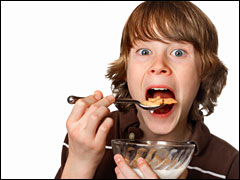Mea culpa. That’s the only way I can honestly write anything about getting older kids to eat healthy foods. Because I’ve been a sucker for the look my 11-year-old gets on her face if I plop down a bowl of nuclear-orange SpongeBob mac-and-cheese in front of her. Sheer joy: that’s the only way to describe it. Ditto for the times she eats (can I admit this?) Cookie Crisp cereal, high-fructose corn syrup laced yogurt, and the occasional bag of Doritos — chips that look toxic enough to qualify as their own Superfund sites.

Open mouth, insert junk food.
Photo: iStockphoto
How have I sunk so low? That age-old problem, complacency, set in, combined with the fact that my daughter in recent years has become increasingly picky and health-food hostile. I let the junk into her life just so she’d eat something — anything — with enthusiasm.
The good news? I’ve turned a corner, thanks to this denial-busting assignment from Grist, with additional thanks to nationally known nutritionist Cynthia Sass, a New York City-based registered dietitian, health expert, and author of the book Your Diet is Driving Me Crazy. Give kids the information they need, Sass convinced me, and they’re going to want to eat right.
“What older children need is a basic understanding about this stuff — about the chemicals and additives and fats and sugars and how it affects their bodies,” she says. “Kids are great critical thinkers.”
The pickiest fifth-grader and the most eye-rolling teen are equally devoted to taking control of their lives, in the food department and all others, she says. Engage their smarts and their natural sense of outrage — about the disodium inosinate in those Doritos and the pesticide residue on that peach — and they’ll become allies in the food fight.
“The key is to avoid trying to trick them, or sway them, or force them to clean their plate or eat in a certain way,” Sass says. Playing the food cop when they’re downing the junky stuff “really pushes them toward those foods.”
By sleuthing with your kids instead of for them — reading labels and finding out together what foods have nasty additives and which fruit juices have no fruit in them and how that strange purple vegetable from the farmers’ market actually tastes — you engage them and bond with them, too.
Simple enough. I asked my daughter this week to read me the label on her maple syrup, which had not a single ingredient that was vaguely related to a maple tree. She was outraged.
Among Sass’s other recommendations:
- Take children to farmers’ markets (check out localharvest.org for a nationwide directory). Put them in charge of picking a different food each time; ask them to choose a variety of colors (they’ll get good phytonutrients along the way).
- Get them cooking and gardening. Kids who help in the kitchen, pick out recipes, and grow the foods they love are likely to love what they eat.
- Create healthy cravings by celebrating with healthy comfort foods. If kids equate cake, ice cream, and candy with birthdays and other special times, they’re likely to have a yen for those foods all their lives.
- Make healthy, organic foods available in the fridge and on the table — and eat those foods yourself. Studies show that one of the greatest influences on eating habits in children up to age 18 is what their parents eat.
- Appeal to your kid’s inner rebel. Tweens and teens are highly offended by unfairness, hidden agendas, and con jobs. Watch the documentary Supersize Me with them or give them Eric Schlosser’s book Fast Food Nation and you might inspire more food activism than you dreamed possible.
For a quick fix, you can also download and print out the list below [PDF] of the eight foods every kid should eschew. Post it somewhere in view and let the chips fall where they may. Which just might be in the trash.
FOODS TO ESCHEW
The foods listed below are more noxious than nutritious — for you and for the earth.
1. Sodas
Teeth go rotten with Coke. A 12-ounce serving of most sodas contains 7 to 10 or more teaspoons of sugar in the form of high-fructose corn syrup, a sweetener that’s linked to rising rates of obesity and diabetes. (To see what this amount of sugar looks like, check this out.) Diet sodas aren’t much better: they’re filled with aspartame, a questionable artificial sweetener, and studies show that people who drink them weigh more than those who don’t.
2. Hot dogs, bacon, and processed lunch meats
It’s no baloney: high-fat meats like hot dogs, salami, and just about everything in your supermarket’s pre-packaged lunches and “deli aisle” are filled with hormones, antibiotics, pesticides, herbicides, and artery-clogging cholesterol and saturated fats. The latter can build up and cause strokes, heart disease, and cancers in adulthood. The nitrites in these meats are linked to increased risks of childhood cancer, too.
3. French fries
Most fries — America’s most popular vegetable dish — wallow in cholesterol-boosting hydrogenated or partially hydrogenated oils, aka transfats. The fats in French fries also seem to cause more deep belly fat accumulation, putting people at risk for diabetes and heart disease. And a single serving of fast-food French fries offers dangerously high levels of acrylamide, a toxic chemical than can cause reproductive damage and cancer.
4. Doh-nuts
Just look at Homer. Doughnuts are the poster-child for food gone wrong: sugar-encased, high-fat packages of refined grains and empty calories, with food-dyed candy sprinkles on top. Plus, it’s hard to eat just one.
5. Juice-flavored drinks
Some fruit juices are actually made with, uh, fruit juice. But most are only about 10 percent juice, plus water, sugar, and juice concentrate (which has almost zero nutritious value). Apple juice promotes tooth decay; over-juicing in general promotes obesity. Eat an actual raw organic fruit instead. If you’re thirsty, drink some (non-bottled) water.
6. Artificial butter-flavored microwave popcorn
Artificially flavored anything is bad for you, but buttery-flavored nuked popcorn has the added problem of releasing toxic fumes, which in large amounts can cause a potentially fatal lung disease called bronchiolitis obliterans — or what’s become known as “popcorn lung.” Hundreds of workers in popcorn factories already suffer from the ailment, and a prominent researcher has warned federal regulators that consumers are also at risk.
7. Chips
Whether they’re potato chips, Doritos, or some other entry in this snack realm, chips are high-fat and high-sodium with almost zippo nutritious value. Like French fries, many are also filled with alarming levels of acrylamide, a chemical that forms spontaneously when starchy foods are baked or fried.
8. Chicken nuggets
Cute as they are, these golden morsels aren’t much more than a greasy, breaded salt-delivery system. They’re filled with cholesterol-raising fats and super-sized loads of sodium. If you’ve seen Morgan Spurlock’s Supersize Me, you’ll also have heard the allegations that Chicken McNuggets were once made with sick chickens. And they’re prepared with chemicals like TBHQ, a form of lighter fluid. Just say McNo.

